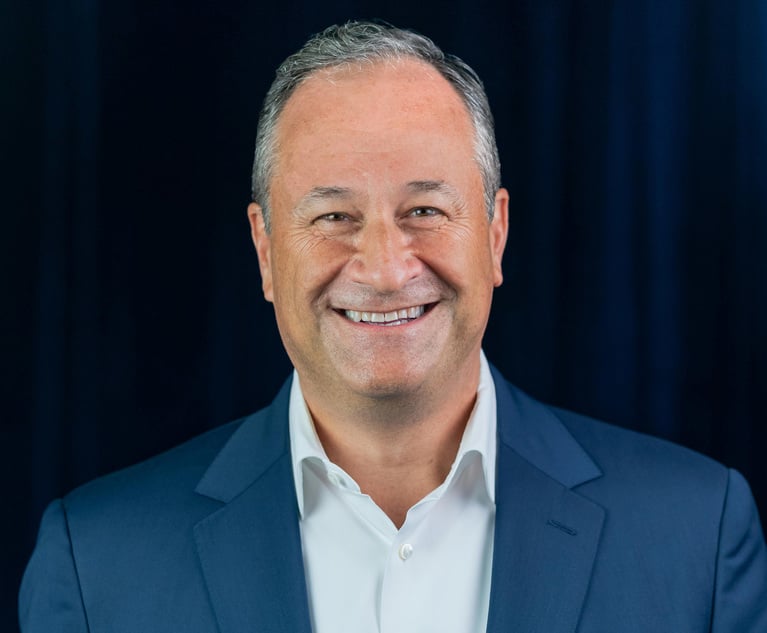Pay Model Evolves at Fried Frank, Paving Way for Outsized Earnings
Industry sources say Lawrence Barshay, a top rainmaker at Fried Frank and brother to Paul Weiss partner Scott Barshay, has earned compensation reaching at least $11 million a year.
August 14, 2018 at 05:28 PM
6 minute read
 Image credit: Shutterstock.com
Image credit: Shutterstock.com
As competition for talent intensifies at the top of the legal market, Wall Street firm Fried, Frank, Harris, Shriver & Jacobson has undertaken significant changes in the last few years, including overhauling its compensation system to become more competitive, tripling its nonequity partner ranks and adopting a partial black box model for partner compensation.
The moves, described to ALM by several attorneys familiar with the firm, are symbolic of the increasingly fierce lateral market among elite firms. They come as other firms have also adjusted their pay models, amid growing pressure to shift away from lockstep seniority-based partner compensation.
For Fried Frank and others, the structural changes have brought flexibility to pay star partners ever greater sums.
Three legal industry sources with knowledge of some Fried Frank compensation details, speaking on condition of anonymity, told ALM that Lawrence Barshay, a top rainmaker at the firm, has lately been paid at least $11 million a year. Barshay, whose book of business is said to be more than $50 million a year, is head of Fried Frank's asset management practice. (His brother, Scott Barshay, was reportedly paid nearly $10 million after joining Paul, Weiss, Rifkind, Wharton & Garrison from Cravath, Swaine & Moore in 2016.)
Fried Frank declined to comment for this article.
While Fried Frank was not completely lockstep in the past, partners in good standing were expected to get a certain number of points as they became more senior, and partners could see what other partners were making.
Moving away from a point system in 2015 allowed the firm to set a target compensation for each partner. The firm will pay at, above or below it depending on the firm's performance in a given year. Some sources familiar with the firm said the system without points has allowed for more flexibility and discretion to award some partners even higher pay than before the change.
Meanwhile, the spread between the highest paid to the lowest paid partners has substantially increased, attorney sources said. Indeed, according to ALM data, Fried Frank's ratio of the highest paid to the lowest paid partner (including equity and nonequity partners) increased to 13:1 in 2017 from 11:1 in 2016.
Fried Frank has also moved to a partial black box system, where all partner pay is not disclosed. However, internally, the firm reveals to partners the compensation of its 10 highest-paid partners, as well as pay to partners on the firm's compensation committee who are not on the top 10 list, attorney sources told ALM. The firm also reveals a scattergram of anonymous partner pay so that partners can see how their pay stacks up against the rest of the partnership.
Amid these changes, the firm has seen explosive profits per partner growth over the last five years. It has also achieved record revenue growth and, some would argue, safeguarded its ability to keep top-performing partners and attract star laterals.
In the last two years, Fried Frank has added finance partner Adam Summers from Cadwalader, Wickersham & Taft; capital markets partner Meredith Mackey from Davis Polk & Wardwell; Matthew Parrott, the former head of Katten Muchin Rosenman's New York real estate and distressed debt litigation group; and Michael Keats, former co-head of the financial services litigation and enforcement practice at Stroock & Stroock & Lavan.
At the same time, the new compensation model represents a shift in culture for the firm, which saw a number of lateral departures in the years since David Greenwald rejoined in 2013 from Goldman Sachs. Greenwald became sole chairman in 2014 when Valerie Ford Jacob, who led the firm for 11 years, stepped down. She is now a partner at Freshfields Bruckhaus Deringer.
While Fried Frank has seen a 124 percent increase in profits per equity partner from 2012 to 2017, the firm has expanded its nonequity ranks and thinned out the equity tier. Fried Frank had 109 equity partners last year, down from 134 in 2012, according to ALM data. Meanwhile, it had 23 nonequity partners last year, up from seven in 2012. (Nonequity partners are those who receive more than half their compensation on a fixed-income basis, according to American Lawyer's methodology.)
Greenwald has implemented a tight focus on the firm's finances and profitability. He told Forbes in 2016 that “all law firms are on a path from being small partnerships in which partners were involved in all decisions to larger organizations with more streamlined and business-like processes. The partnership model has many strengths, but there are risks associated with it too.”
He said at the time that the firm moved to a merit-based system from a modified lockstep because “the merit-based approach was largely aligned with the way in which we determined compensation anyway. So it made sense to formalize the process. In doing so, we are strengthening our ability to attract and retain the very best talent. A merit-based system enables us to reward the behaviors we want and to hold people accountable.”
Fried Frank is far from alone in revising its compensation system to become more competitive. As the New York Law Journal previously reported, Simpson Thacher & Bartlett has lately broadened its pay scale for partners. Meanwhile, some Magic Circle firms have broken their lockstep structure to compete in the U.S.
“Tons of firms are looking at their compensation systems,” said law firm management consultant Lisa Smith, who often sees changes in partner pay and bonus pools result in a wider spread between the lowest to highest paid partners. “The spread is widening, but it's not like everybody is moving to the top. It's only a few outliers,” said Smith, a consultant at Fairfax Associates who spoke generally on partner compensation trends.
Sometimes internal tensions arise from those compensation changes. “One of the things that keep managing partners up at night is how do you get the right balance. There is a little bit of a zero-sum game,” she said. Adding the extra money given to star performance has “got to come from somewhere,” Smith said. “That's what gives some people some pause: Can you have that big of a gap?”
Overall, she said, firms are seeking a delicate balance to reward their top business generators and “figure out how to reward teamwork and encourage partners to collaborate.”
This content has been archived. It is available through our partners, LexisNexis® and Bloomberg Law.
To view this content, please continue to their sites.
Not a Lexis Subscriber?
Subscribe Now
Not a Bloomberg Law Subscriber?
Subscribe Now
NOT FOR REPRINT
© 2025 ALM Global, LLC, All Rights Reserved. Request academic re-use from www.copyright.com. All other uses, submit a request to [email protected]. For more information visit Asset & Logo Licensing.
You Might Like
View All
Five Years After Vega Much Remains Unsettled in Pay Frequency Litigation

Spotify GC Steps Down, Opts to 'Step Away From Full-Time Corporate Life'
2 minute read
Dechert Sues Former Attorney For Not Returning Compensation

Trending Stories
- 1Class Action Litigator Tapped to Lead Shook, Hardy & Bacon's Houston Office
- 2Arizona Supreme Court Presses Pause on KPMG's Bid to Deliver Legal Services
- 3Bill Would Consolidate Antitrust Enforcement Under DOJ
- 4Cornell Tech Expands Law, Technology and Entrepreneurship Masters of Law Program to Part Time Format
- 5Divided Eighth Circuit Sides With GE's Timely Removal of Indemnification Action to Federal Court
Who Got The Work
J. Brugh Lower of Gibbons has entered an appearance for industrial equipment supplier Devco Corporation in a pending trademark infringement lawsuit. The suit, accusing the defendant of selling knock-off Graco products, was filed Dec. 18 in New Jersey District Court by Rivkin Radler on behalf of Graco Inc. and Graco Minnesota. The case, assigned to U.S. District Judge Zahid N. Quraishi, is 3:24-cv-11294, Graco Inc. et al v. Devco Corporation.
Who Got The Work
Rebecca Maller-Stein and Kent A. Yalowitz of Arnold & Porter Kaye Scholer have entered their appearances for Hanaco Venture Capital and its executives, Lior Prosor and David Frankel, in a pending securities lawsuit. The action, filed on Dec. 24 in New York Southern District Court by Zell, Aron & Co. on behalf of Goldeneye Advisors, accuses the defendants of negligently and fraudulently managing the plaintiff's $1 million investment. The case, assigned to U.S. District Judge Vernon S. Broderick, is 1:24-cv-09918, Goldeneye Advisors, LLC v. Hanaco Venture Capital, Ltd. et al.
Who Got The Work
Attorneys from A&O Shearman has stepped in as defense counsel for Toronto-Dominion Bank and other defendants in a pending securities class action. The suit, filed Dec. 11 in New York Southern District Court by Bleichmar Fonti & Auld, accuses the defendants of concealing the bank's 'pervasive' deficiencies in regards to its compliance with the Bank Secrecy Act and the quality of its anti-money laundering controls. The case, assigned to U.S. District Judge Arun Subramanian, is 1:24-cv-09445, Gonzalez v. The Toronto-Dominion Bank et al.
Who Got The Work
Crown Castle International, a Pennsylvania company providing shared communications infrastructure, has turned to Luke D. Wolf of Gordon Rees Scully Mansukhani to fend off a pending breach-of-contract lawsuit. The court action, filed Nov. 25 in Michigan Eastern District Court by Hooper Hathaway PC on behalf of The Town Residences LLC, accuses Crown Castle of failing to transfer approximately $30,000 in utility payments from T-Mobile in breach of a roof-top lease and assignment agreement. The case, assigned to U.S. District Judge Susan K. Declercq, is 2:24-cv-13131, The Town Residences LLC v. T-Mobile US, Inc. et al.
Who Got The Work
Wilfred P. Coronato and Daniel M. Schwartz of McCarter & English have stepped in as defense counsel to Electrolux Home Products Inc. in a pending product liability lawsuit. The court action, filed Nov. 26 in New York Eastern District Court by Poulos Lopiccolo PC and Nagel Rice LLP on behalf of David Stern, alleges that the defendant's refrigerators’ drawers and shelving repeatedly break and fall apart within months after purchase. The case, assigned to U.S. District Judge Joan M. Azrack, is 2:24-cv-08204, Stern v. Electrolux Home Products, Inc.
Featured Firms
Law Offices of Gary Martin Hays & Associates, P.C.
(470) 294-1674
Law Offices of Mark E. Salomone
(857) 444-6468
Smith & Hassler
(713) 739-1250






